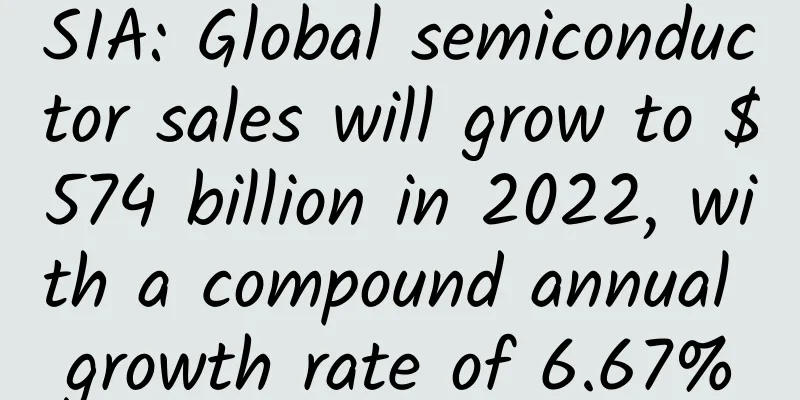SIA: Global semiconductor sales will grow to $574 billion in 2022, with a compound annual growth rate of 6.67%

|
The Semiconductor Industry Association (SIA) released the 2023 SIA Factbook, an overview of the U.S. semiconductor industry in 2023, which provides an overview of the current status of the U.S. semiconductor industry from five aspects: global semiconductor industry overview, global semiconductor market, U.S. semiconductor capital expenditure and R&D investment, U.S. semiconductor industry jobs, and U.S. semiconductor industry productivity. 1. Overview of the semiconductor industry INDUSTRY OVERVIEW The global semiconductor industry is a key sector for global economic growth The Global Semiconductor Industry is a Key Growth Sector in the Global Economy Global semiconductor sales will increase from US$139 billion in 2001 to US$574 billion in 2022, with a compound annual growth rate of 6.67%. According to the World Semiconductor Trade Statistics (WSTS) fall 2022 forecast, global semiconductor market sales will decline to US$556 billion in 2023, but will resume growth to a record high of US$602 billion in 2024. The US semiconductor industry accounts for nearly half of the global market share The US Semiconductor Industry has Nearly Half the Global Market Share In the 1980s, the U.S. semiconductor industry's global market share declined significantly. In the early 1980s, U.S. producers accounted for more than 50 percent of global semiconductor sales. Due to intense competition from Japanese companies, the effects of illegal "dumping," and a severe industry recession from 1985 to 1986, the U.S. industry lost a total of 19 market share points in the global market and ceded global industry market share leadership to the Japanese semiconductor industry. Over the next decade, the U.S. industry rebounded, and by 1997 it had regained leadership with more than 50% of the global market share, a position it still holds today. U.S. semiconductor companies have maintained their competitive advantage in microprocessors and other cutting-edge devices and continue to lead in a range of other product areas. In addition, U.S. semiconductor companies maintain their leadership in R&D, design, and process technology. Today, American companies have the largest market share, reaching 48%. Other countries' industries have a global market share between 7% and 20%, including South Korea 19%, Europe 9%, Japan 9%, Taiwan 8%, and mainland China 7%. The sales of US semiconductor companies show an increasing trend year by year US-Based Semiconductor Company Sales have Displayed Steady Annual Growth Sales of semiconductor companies headquartered in the United States grow from $71.1 billion in 2001 to $275 billion in 2022, a compound annual growth rate of 6.7%. Sales growth of companies headquartered in the United States exhibits the same cyclical fluctuations as the industry as a whole. U.S. semiconductor companies maintain market share leadership in key regions US-BASED SEMICONDUCTOR COMPANIES MAINTAIN MARKET SHARE LEADERSHIP IN MAJOR REGIONAL SEMICONDUCTOR MARKETS In 2022, the sales of semiconductor companies headquartered in the United States totaled $275 billion, accounting for 48% of the global market. At the same time, in all national and regional semiconductor markets, companies headquartered in the United States also occupy a leading position in sales market share. For example, in the Chinese market, the market share of American companies is as high as 53.4%. Semiconductors are one of the largest U.S. exports Semiconductors are One of America's Top Exports In 2022, U.S. semiconductor exports were $61.1 billion, ranking fifth among U.S. exports, behind only refined petroleum products, aircraft, crude oil and natural gas. Semiconductors make up the largest share of all U.S. electronics exports. 2. Global semiconductor market: Diversification and consumption drive GLOBAL MARKET: Diversified and Consumer-driven Global semiconductors are driven by what consumers buy Global Semiconductor Sales are Driven by Products Ultimately Purchased by Consumers The vast majority of semiconductor demand is driven by products that consumers ultimately purchase, such as laptops or smartphones. Increasingly, it is driven by consumer demand in emerging markets, including Asia, Latin America, Eastern Europe and Africa. Global semiconductor sales are diversified by product type Global Semiconductor Sales are Diversified by Type of Product Sold As semiconductor technology advances rapidly, more advanced products and process technologies are developed and applied to end-use industries. In recent years, the largest segments of the global semiconductor industry have been memory, logic, analog, and MPU. In 2022, these products accounted for 78% of semiconductor industry sales. In terms of year-on-year growth rate, MCU had the highest growth rate, reaching 28%, followed by analog chips (+20%), logic chips (+14%), and sensors (+14%). The memory chip market was the only declining market, down 16% year-on-year. Asia Pacific is the largest regional semiconductor market, and China is the largest single-country market Asia Pacific is the Largest Regional Semiconductor Market, and China is the Largest Single-Country Market In 2001, as electronic equipment production shifted to the Asia-Pacific region, sales in the Asia-Pacific market surpassed all other regional markets. Since then, it has multiplied in size, from $39.8 billion to $330.94 billion in 2022. By far the largest market in the Asia-Pacific region is China, which accounts for 55% of the Asia-Pacific market and 31% of the global total. This data reflects sales of semiconductors only to electronic equipment manufacturers - the final electronic products containing semiconductors are then shipped and consumed around the world. 3. Capital and R&D investment: the driving force for maintaining the competitiveness of the U.S. semiconductor industry Capital and R&D Investment: A Driving Force in Maintaining a Competitive US Semiconductor Industry The semiconductor industry invests heavily in capital and R&D each year Total Annual Levels of Investment in Capital and R&D are High for the Industry In 2022, total R&D and capital expenditures of U.S. semiconductor companies, including fabless semiconductor companies, were $109.6 billion. The compound annual growth rate is approximately 6.3% from 2001 to 2022. In terms of sales share, investment levels are generally not affected by fluctuations related to market cyclicality. Capital and R&D investment are key to maintaining the competitiveness of the U.S. semiconductor industry Capital and R&D Investment are Critical to Maintaining a Competitive US Semiconductor Industry To remain competitive in the semiconductor industry, companies must continually invest large amounts of revenue in research and development and in new factories and equipment. The pace of technological change in the industry requires companies to develop more sophisticated designs and process technologies and introduce production machinery capable of manufacturing components of smaller dimensions. The ability to design and produce the most advanced semiconductor components can only be maintained by a constant commitment to keep up with the industry-wide investment rate of approximately 30% of sales. The need to stay ahead of the curve led to some extreme volatility in years such as 2001 and 2002, when sales fell sharply while R&D and capital equipment spending did not fall at the same rate. Capital expenditures and R&D investment per employee in the U.S. fall to $201,000 in 2022 INVESTMENT IN CAPITAL EXPENDITURES AND R&D PER EMPLOYEE DECLINED TO $201,000 IN 2022 From 2001 to 2022, Micron's total semiconductor industry investment per employee (measured in total R&D and new factories and equipment) increased by approximately 4.2% per year. Those expenditures topped $100,000 in 2001 but fell to about $91,000 in 2003 following the 2001 recession. Investments per employee increased to over $100,000 in 2006. The 2008-2009 recession caused investments per employee to drop in 2009 and 2010, but they recovered in 2012 and grew to $201,000 in 2022. R&D spending in the U.S. semiconductor industry remains high, reflecting the intrinsic importance of R&D to semiconductor production. US SEMICONDUCTOR INDUSTRY R&D EXPENDITURES ARE CONSISTENTLY HIGH, REFLECTING THE INHERENT IMPORTANCE OF R&D TO SEMICONDUCTOR PRODUCTION From 2001 to 2022, the U.S. semiconductor industry's R&D spending grew at a compound annual growth rate of about 7%. Regardless of the annual sales cycle, U.S. semiconductor companies' R&D spending tends to be high, reflecting the importance of R&D investment to semiconductor production. In 2022, the U.S. semiconductor industry's R&D investment totaled $58.8 billion. Over the past 20 years, the average annual R&D investment of the U.S. semiconductor industry has exceeded 15%. ANNUAL R&D EXPENDITURES AS A PERCENT OF SALES HAVE EXCEEDED 15 PERCENT OVER THE PAST 20 YEARS, AMONG THE HIGHEST RATES FOR ANY US INDUSTRY Over the past 20 years, U.S. semiconductor companies have averaged more than 15% of their annual R&D spending as a percentage of sales, a rate unprecedented among the major manufacturing sectors of the U.S. economy. R&D spending is critical to the competitive position of semiconductor companies. The rapid pace of technological change requires continuous advancements in process technology and equipment capabilities. The increase in R&D in 2001 and 2002 was due to the industry's commitment to the future of technology despite the economic recession. The declines in 2003-2004 and 2020-2021 were not due to cuts in R&D budgets, but rather to stronger-than-expected industry growth and faster-than-expected revenue growth. U.S. semiconductor industry spends more on R&D than most tech industries THE US SEMICONDUCTOR INDUSTRY IS A LEADER IN R&D SPENDING AS A PERCENT OF SALES AMONG MAJOR US INDUSTRIES The U.S. semiconductor industry ranks among the top major high-tech industrial sectors in terms of R&D expenditure. According to the 2022 EU Industrial R&D Investment Scoreboard, in terms of R&D expenditure as a percentage of sales, the U.S. semiconductor industry accounts for 18.75% of R&D, second only to the U.S. pharmaceutical and biotechnology industry at 21.4%. The level of R&D spending in the U.S. semiconductor industry is much higher than that in other countries THE US SEMICONDUCTOR INDUSTRY SPENDS MORE ON R&D AS A PERCENT OF SALES THAN ANY OTHER COUNTRY'S SEMICONDUCTOR INDUSTRY According to the 2022 EU Industrial R&D Investment Ranking, in 2022, R&D expenditure of the US semiconductor industry accounted for as much as 18.75% of total sales, much higher than the semiconductor industries in other countries, and nearly 2.5 times the R&D expenditure of China's semiconductor industry (7.6%). Note: Slight differences in semiconductor industry share from page 18 table due to differences in methodology and source data. Source: The 2022 EU Industrial R&D Investment Scoreboard. The U.S. semiconductor industry accounts for a high proportion of annual equipment expenditures THE US SEMICONDUCTOR INDUSTRY IS HIGHLY CAPITAL INTENSIVE, AND ANNUAL INDUSTRY SPENDING ON CAPITAL EQUIPMENT TENDS TO BE HIGH AS A SHARE OF SALES Capital expenditures for the U.S. semiconductor industry total $50.7 billion in 2022. Capital expenditures are down from 2001-2003 due to major new facility completions during the 1999-2001 period and increased use of foundries. There was a rebound in 2004, and in 2005 the industry was in equilibrium in terms of capital expenditures as a percentage of sales. After falling sharply in 2009 due to the global recession, capital expenditures rebounded to $23.7 billion in 2011. Capital spending exceeded $50 billion in 2022 as chipmakers increased production capacity to meet a surge in demand for semiconductors. U.S. semiconductor industry capital expenditures to exceed 15% of total sales for the first time in 2022 ANNUAL CAPITAL EXPENDITURES AS A PERCENT OF SALES HAVE AVERAGED BETWEEN 10 AND 15 PERCENT OVER THE PAST 20 YEARS, AND EXCEEDED 15% FOR THE FIRST TIME IN 2022 Capital expenditures as a percentage of sales have exceeded 10% in all but two of the past 20 years. This is extremely high for a major manufacturing sector in the U.S. economy. For semiconductor manufacturers, capital expenditures are critical to their competitive position. The rapid pace of innovation in the industry requires large amounts of capital expenditures to continue to produce more advanced equipment. 4. Employment in the U.S. Semiconductor Industry US JOBS The U.S. semiconductor industry accounts for 250,000 direct U.S. jobs and an additional 1 million-plus indirect jobs in the United States. 5. U.S. Semiconductor Industry Productivity US PRODUCTIVITY Over the past 20 years, U.S. semiconductor companies have seen rapid productivity gains. Labor productivity in the U.S. semiconductor industry has more than doubled since 2001. These productivity gains have been achieved by maintaining high capital investment levels and R&D spending rates. In 2022, the average sales revenue per employee in the U.S. semiconductor industry exceeded $607,000. 6. U.S. Semiconductor Industry Map US PRODUCTIVITY The semiconductor ecosystem in the United States is broad and diverse, especially when the US Chips and Science Act was proposed in the spring of 2020 and officially took effect in August 2022. By March 2023, many companies in the semiconductor ecosystem announced dozens of projects: 19 states announced more than $210 billion in new private investments to increase domestic manufacturing capacity; More than 50 new semiconductor ecosystem projects were announced across the U.S., including construction of new fabs, expansions of existing sites, and facilities that provide materials and equipment used in chip manufacturing; As part of the new program, 44,000 new high-quality jobs were announced in the semiconductor ecosystem, which will support even more jobs throughout the U.S. economy. At the end of March this year, SIA launched the U.S. semiconductor industry ecosystem map, showing nearly 500 semiconductor locations in 42 states, consisting of semiconductor manufacturing, chip design, intellectual property and chip design software suppliers, semiconductor materials and manufacturing equipment, and R&D, including the Semiconductor Research Corporation (SRC)'s university R&D partners and the National Nanotechnology Coordinated Infrastructure (NNCI). Chip Intelligence |
<<: Qvod server stores more than 3,000 pornographic videos
>>: iTunes 11.2 Update Download: Improved Podcast Browsing
Recommend
Tips for promoting and attracting traffic on Weibo!
Weibo can be said to be a big brother-level platf...
The cognitive science of weight loss: How we deceive ourselves and fail to lose weight step by step
The cognitive science of weight loss: How we tric...
Yutu-2 discovers mysterious cabin on the moon
October 29, 2021, afternoon "Yutu-2" fr...
Wuji Doudian fruit category full-case gameplay, Douyin store fruit practice class, 2022 Douyin e-commerce bonus outlet
Wuji Doudian fruit category full-case gameplay, D...
Practical case: How to build a user churn warning system!
Instead of waiting for users to churn and then us...
5 copywriting skills, do you master them if you are in operation?
There are two characteristics of excellent operat...
Implementing the animation effect of flipping cards
In Android design, card elements are often used, ...
If I accidentally eat the "oil" from a gel pen, is it okay?
Review expert: Gan Qiang, lecturer at Beijing Ins...
WeChat operation: 20 self-media platforms that self-media people must know
Dingdian started out as a channel developer, so i...
Mobile APP is suitable for the elderly + barrier-free transformation, breaking the digital divide
Labs Guide With the continuous development of sci...
WhatsApp will allow transfer of chat history between iOS and Android devices
Mobile messaging app WhatsApp is adding the abili...
Rare! Very beautiful! 丨Base construction
Review expert: Gu Mingdi Lian (He Lin), a well-kn...
B2B Marketing Promotion!
The article shares practical experience and thoug...
Don’t be fooled by its beauty, it can bite off a lobster’s claws in one bite!
Have you ever seen a fish that looks like a puffe...
Bright blue iPhone 7 stunning unboxing in China: third-party customized luxury packaging
Apple has spent a lot of effort on the iPhone 7, n...









